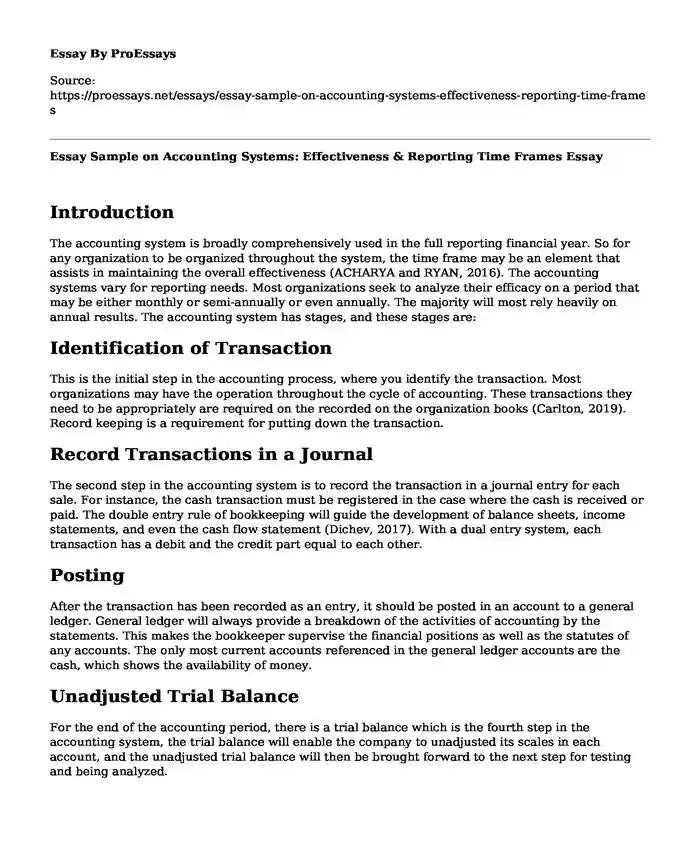Introduction
The accounting system is broadly comprehensively used in the full reporting financial year. So for any organization to be organized throughout the system, the time frame may be an element that assists in maintaining the overall effectiveness (ACHARYA and RYAN, 2016). The accounting systems vary for reporting needs. Most organizations seek to analyze their efficacy on a period that may be either monthly or semi-annually or even annually. The majority will most rely heavily on annual results. The accounting system has stages, and these stages are:
Identification of Transaction
This is the initial step in the accounting process, where you identify the transaction. Most organizations may have the operation throughout the cycle of accounting. These transactions they need to be appropriately are required on the recorded on the organization books (Carlton, 2019). Record keeping is a requirement for putting down the transaction.
Record Transactions in a Journal
The second step in the accounting system is to record the transaction in a journal entry for each sale. For instance, the cash transaction must be registered in the case where the cash is received or paid. The double entry rule of bookkeeping will guide the development of balance sheets, income statements, and even the cash flow statement (Dichev, 2017). With a dual entry system, each transaction has a debit and the credit part equal to each other.
Posting
After the transaction has been recorded as an entry, it should be posted in an account to a general ledger. General ledger will always provide a breakdown of the activities of accounting by the statements. This makes the bookkeeper supervise the financial positions as well as the statutes of any accounts. The only most current accounts referenced in the general ledger accounts are the cash, which shows the availability of money.
Unadjusted Trial Balance
For the end of the accounting period, there is a trial balance which is the fourth step in the accounting system, the trial balance will enable the company to unadjusted its scales in each account, and the unadjusted trial balance will then be brought forward to the next step for testing and being analyzed.
Worksheet
To analyze means to examine a worksheet and identify the adjusting the entries that compose the fifth step in the process, the spreadsheet that is created and used ensures the debit and credit are the same. And if there will be differentials, then the changes will be required. For the identification of any errors, tuning the entries will be needed for the revenues and expenses corresponding when in use of accrual accounting.
Adjusting Journal Entries
This stage is where the necessary adjustment of the transaction is appropriately and correctly recorded in the books of accounts and showing the correct journal entries.
At this stage, the organization will ensure all the adjustments that were made. At this point is where the generation of financial statements is made. Most companies prepare the statements such as the statement of comprehensive income, statement of financial position the cash flow statement (Income Statement vs. Comprehensive Income Statement, 2019).
Conclusion
To finish, the company will end the accounting process at this stage by making the closure of books of accounts at every accounting period on a specified date (The Impact of Company Accounts on Accounting Information Generation for Decision Making of Small and Medium Enterprises in Nigeria, 2020). After closure, the accounting cycle will again start over again, starting a new period.
References
ACHARYA, V.V., and RYAN, S.G. (2016). Banks' Financial Reporting and Financial System Stability. Journal of Accounting Research, 54(2), pp.277–340.
Carlton, D.W. (2019). Transaction costs and competition policy. International Journal of Industrial Organization, p.102539.
Dichev, I.D. (2017). Re-Orienting the Statement of Cash Flows around Cash Flows to Equity Holders. SSRN Electronic Journal.
Income Statement vs. Comprehensive Income Statement. (2019). European Journal of Business and Management.
The Impact of Company Accounts on Accounting Information Generation for Decision Making of Small and Medium Enterprises in Nigeria. (2020). Research Journal of Finance and Accounting.
Cite this page
Essay Sample on Accounting Systems: Effectiveness & Reporting Time Frames. (2023, Oct 15). Retrieved from https://proessays.net/essays/essay-sample-on-accounting-systems-effectiveness-reporting-time-frames
If you are the original author of this essay and no longer wish to have it published on the ProEssays website, please click below to request its removal:
- Essay Sample: Hilton Hotels and Resorts - Marketing Segmentation and Strategy
- Geek Squad Brand Assessment With Recommendation Letter
- Does Bank Stress Test Help to Mitigate Systemic Risk?
- Essay Sample on Business and Entrepreneurship
- Business Ethics Reflection Essay Example
- Paper Example on Occupational Safety & Health: Ensuring Workplace Wellbeing
- Essay Example on Entrepreneurship: Creating, Visioning & Innovating







